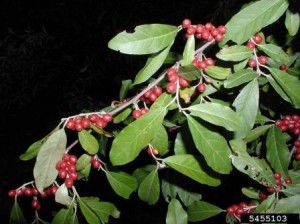Introduced to the U.S. from Asia, autumn olive is a fast-growing woody shrub or tree that can attain 20 feet in height. It has simple, alternate oval leaves with silvery undersides (but not as silvery as Russian olive). The fragrant small white flowers reach peak bloom around mid-May. The fleshy fruits are brown at first but gradually turn red with silvery dots. Autumn olive has been planted extensively for wildlife habitat, strip mine re-vegetation, and erosion control, and also has been marketed widely as an ornamental. It produces abundant fruits that are consumed and spread by birds and small mammals. Autumn olive grows well in disturbed areas, open fields, forest margins, roadsides, and clearings. While tolerant of drought, it does not grow well in wet sites. It is intolerant of shade and will not invade dense forests. However, because its fruits are eaten by a variety of wildlife, its seeds may be distributed into forest openings or open woodlands.
A. Hand Pulling:
Autumn olive is effectively controlled by manual removal of young seedlings. Plants should be pulled as soon as they are large enough to grasp, but before they produce seeds. Seedlings are best pulled after a rain when the soil is loose. The entire root must be removed since broken fragments may re-sprout.
B. Cutting:
Cut trees at ground level with power or manual saws. Cutting is most effective when trees have begun to flower to prevent seed production. Because autumn olive spreads by suckering, re-sprouts are common after cutting. Cutting is an initial control measure, and success will require either herbicide application or repeated cutting of re-sprouts.
C. Girdling:
Use this approach for large trees. Using a hand-axe, make a cut through the bark approximately 15 cm (6 in) above the ground, and cut completely around the trunk. Be sure that the cut goes well into or below the cambium layer. This method will kill the top of the tree but re-sprouts are common, and may require follow-up treatments for several years.
D. Herbicides:
Autumn olive tends to be more susceptible to triclopyr than to glyphosate, especially prior to late summer. Where possible, foliar sprays are effective once the leaves are fully expanded. For larger trees, three approaches are possible: 1) Girdle the tree (see description above) with an axe, and apply undiluted triclopyr in the cut around the trunk; 2) Cut down tree and apply undiluted triclopyr into the freshly cut surfaces of the stump to prevent re-sprouting, or 3) Cut down tree and spray re-sprouts before they get too tall to spray.
BRUSH-B-GON [triclopyr (8%)]:
Foliar spray: 4 fl. oz./gal
Cut-stump treatment: Undiluted
ROUNDUP [glyphosate (41%)]:
Foliar spray: 2.5 fl. oz./gal
Cut-stump treatment: Diluted with equal part water (1:1)
References
Sather, N. and N. Eckardt. 1987. Element Stewardship Abstract for Elaeagnus umbellata (Autumn olive). The Nature Conservancy.
Tennessee Exotic Plant Management Manual, April 1997.
